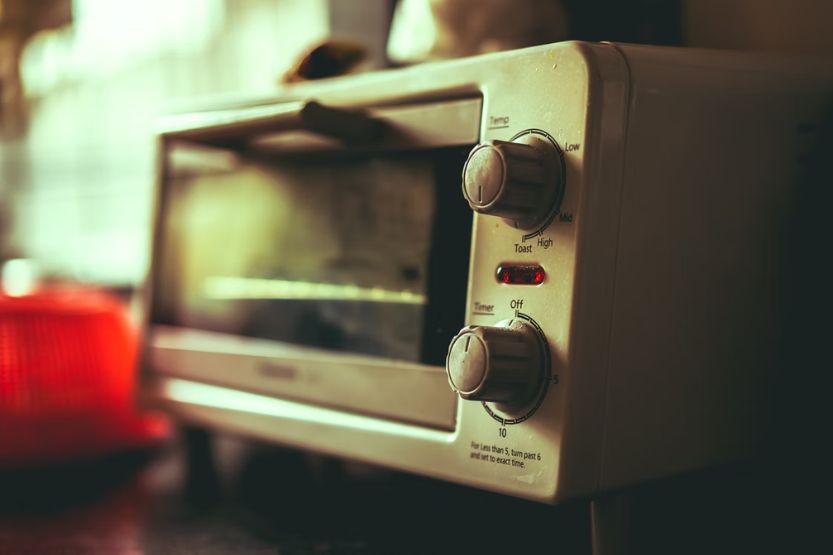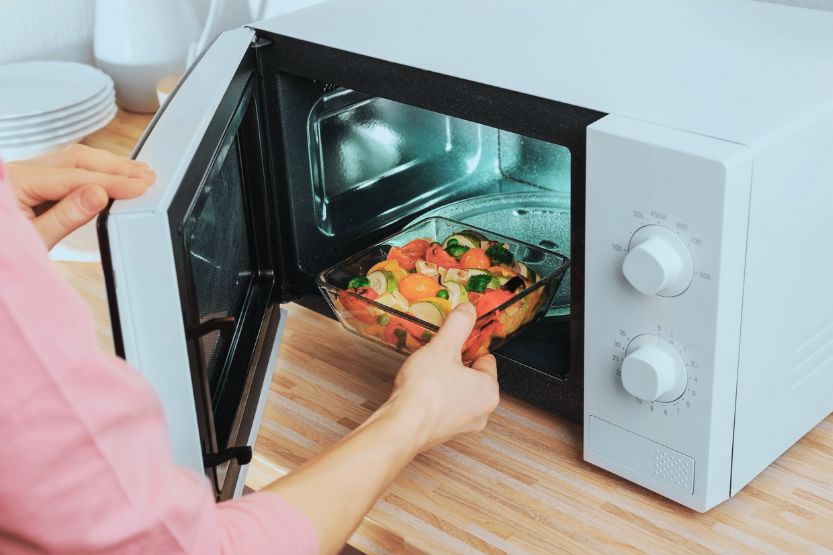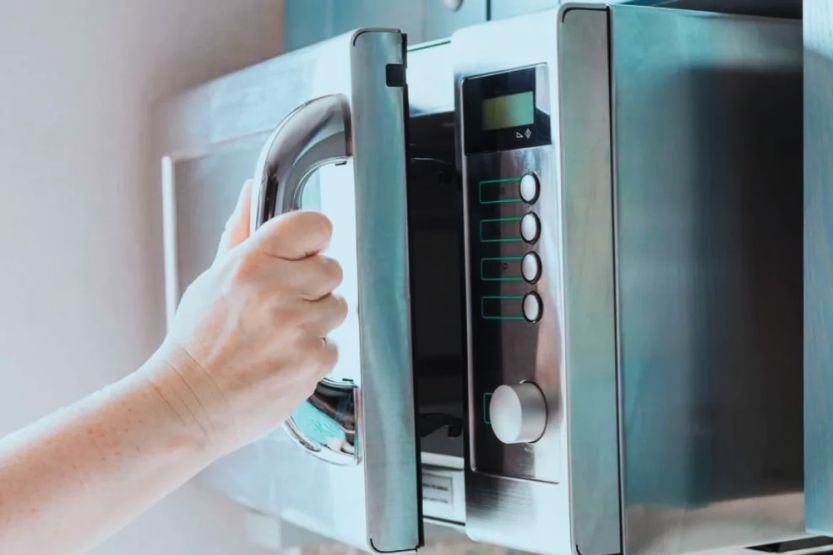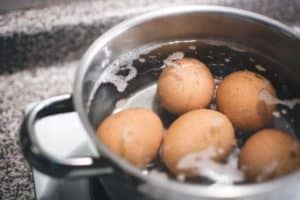Microwaves are used for many purposes, from warming soup to cooking frozen meals and even defrosting food. Their power and efficiency make them a great way to save time cooking at home or work. But how hot do microwaves get?
The microwave doesn’t get hot on its own but instead derives its heat from the food. The amount of heat is determined by what you put inside the appliance. Most microwaved foods get a maximum temperature of 100°C (212°F), which is the water’s boiling point.
However, water can also be superheated to 120°C (248°F). This happens if the water is pure, the container is free of scratches, and the microwave is left undisturbed.
Read on to find out how microwave ovens work and how hot microwaves get, including some factors that influence microwave temperature.
How Does a Microwave Oven Work?

You’re probably pretty used to your microwave oven by now. You use it to reheat leftovers, melt butter, and even make popcorn. But do you know how it works?
Food Molecules Vibrate and Produce Heat
Contrary to popular belief, a microwave oven does not heat food like a stove or conventional oven. Instead, a microwave excites the food’s molecules, causing them to vibrate and brush against one another.
Similar to how your hands generate heat when you rub them together, the molecules vibrate and produce heat.
Food Absorbs the Waves
Your microwave oven emits radio waves into the cooking cavity at a distance of 12 cm or 4.7 in. when it is turned on.
These 12 cm waves will penetrate glass, plastic, paper, and ceramics, as your Wi-Fi and TV signals can penetrate through doors and walls. In contrast, food will absorb the waves after they bounce off metal surfaces.
Microwaves Flip Food Molecules Back and Forth
Food molecules flip back and forth when the microwaves go through them, mimicking the zigzag motion of the waves, particularly the molecules of water, fat, and sugar.
When microwaves flow through food, they flip molecules 2.45 billion times per second due to their 2.45GHz frequency. This quick back-and-forth movement produces heat in the food and is referred to as dielectric heating.
As previously mentioned, the waves penetrate materials like paper, ceramics, plastic, and glass. Any heat you feel on the container results from the hot food touching it rather than the microwave.
Components of a Microwave Oven
The microwave uses several components to heat any meal quickly. The magnetron, which transforms electricity into microwaves, is the essential component.
Other microwave components are as follows:
- Waveguide – It directs the magnetron’s waves toward the food compartment.
- Stirrer – To move microwaves throughout the food container.
- Rotating platform – To cook the food uniformly throughout.
What Is the Maximum Temperature Can a Microwave Reach?
As mentioned above, the food or item within the microwave — not the appliance itself — gets heated. Even microwave models with temperature probes tell the food’s temperature rather than the microwave’s temperature.
Therefore, the correct question isn’t: “What maximum temperature can a microwave reach?” What should be asked is: “What is the maximum temperature food or objects can reach in a microwave oven?”
Maximum Temperature of Microwaved Food or Objects
Microwave ovens do not have any temperature settings compared to conventional ovens. Until you turn off the microwave, it will keep heating up.
So the highest temperature is just before the microwave destroys the object. Due to the various thermal properties of food and objects, this temperature will differ from one material to another.
Close to the Water’s Boiling Point (212°F )
But the most common application of microwaves is for heating food. Additionally, almost all foods contain water. So, the highest temperature food can reach without becoming inedible is close to 212°F (100°C), the water’s boiling point.
The water in the food evaporates at this temperature and leaves the food. The food will probably begin to burn once all the water has evaporated.
Superheated Water (248°F or 120°C)
However, a microwave can superheat water to a temperature of 248°F (120°C). This happens when heating pure water in an unscratched container, and the microwave is left on without interruption.
You risk scalding yourself when you pick up a container of superheated water. For this reason, you must leave a wooden or plastic spoon in the water. The spoon will stop the water from superheating by stirring up its surface and enabling it to reach its normal boiling point.
What Factors Influence Microwave Temperature?

Microwaving food can be more energy efficient than traditional cooking methods since the food cooks faster and the heat only affects the food, not the container. According to the U.S. Food & Drug Administration, microwave-heated food may be healthier than conventionally cooked food.
Temperature, as you may know, influences how quickly foods cook. In a microwave, the speed with which you can reach temperatures high enough to cook food is determined by several factors, including:
- Size and shape of the food
- Amount of water
- Food container’s size
- Microwave Cavity’s Size
- Food’s Initial Temperature
- Appliance’s power and wattage
1. Microwave Wattage
Depends on Magnetron’s Size
Microwave wattage is undoubtedly the most important factor to know when it comes to how hot microwaved foods get. It ranges from 500-1,200 watts and depends on the magnetron’s size, which is the component of your microwave oven that emits microwaves.
More Power Isn’t Necessarily Better
Regarding microwave ovens, higher wattage indicates they can heat food faster than those with lower wattage. However, keep in mind that greater power isn’t necessarily better.
700- to 1000-Watt Microwaves Is Enough
Microwaves with 700 to 1000 watts are enough for most cooking and heating operations. For most cooking jobs, anything less than 700 watts is not enough.
For example, cooking at 700 watts in a microwave oven is equivalent to cooking at 350 degrees in a conventional oven.
The time it takes for your food to heat up is reduced by 10% for every 100 watts of added power. Let’s assume your favorite recipe calls for you to microwave something for two minutes on high in a 700-watt microwave oven.
If you’re using a 1,000-watt microwave, you’ll need to reduce the cooking time or power level by around 30% to avoid overcooking the food. In other words, you should reduce the cooking time to 1 minute and 40 secs or set the power to 7.
Know Your Microwave’s Wattage
Many consumers today have no idea what the wattage of their microwaves is. You may find the wattage of your microwave by checking its manual or looking at the microwave’s inside door, back, or bottom.
How Many Amps Does a Microwave Use?
2. Amount of Water
When heating food in the microwave oven, it’s important to remember that microwaves highly affect water molecules. This means foods with high water content will heat up faster than those with less moisture.
Factors That Determine How Long It Takes to Boil Water in Microwave
3. Microwave Cavity’s Size
This factor determines how many microwaves will hit the food and for how long. A larger cavity will heat an object more slowly than a smaller one.
Again, how hot does a microwave get? When heating food or liquid using a microwave oven, only the food, not the oven, becomes heated. The food’s temperature can reach up to 212°F.
4. Food Size and Shape
The same is true in a microwave as in any other oven: larger amounts of food take longer to heat up, and round shapes absorb microwaves more effectively than rectangles or ovals.
5. Food’s Initial Temperature
Even if you microwave a small piece of cold meat, it will take longer to heat than a larger piece of meat already at room temperature. Similarly, if you microwave frozen food, it will take longer to heat up.
Can You Microwave Parchment Paper?
Do Microwaves Shut Down If They Get Too Hot?

Although it’s extremely unusual, it’s still possible for your microwave to overheat. One situation is when you microwave foods that contain little to no moisture.
Food Is Heated Without Moisture
Food will heat up very quickly if there is no moisture present. Your microwave’s magnetron could overheat if there is no way for it to dissipate the extra heat. If this happens, an automatic shutdown safety mechanism could trip, cutting off power to your microwave oven.
Malfunctioning Microwave Fan
Another possibility is if the microwave’s fan breaks down. Your microwave fan is in charge of cooling the magnetron and expelling extra heat from the oven. If the fan stops operating, your microwave will soon heat up and shut off.
Typically, you can hear when the fan in your microwave oven stops running. If you turn on your microwave and hear nothing from the fan, the appliance may have a problem.
Don’t risk heating food in your broken microwave oven if this is the case. Instead, call a professional.
Automatic Shut-Off Control
When the temperature of the microwave source rises too high, automatic shut-off controls cut off the heating element in the microwave. Its purpose is to safeguard the microwave by avoiding overheating, which could result in mechanical or electrical failure.
The microwave source will turn off when it reaches a certain temperature. However, functions like the timer and clock should keep on working, although this wouldn’t be the case if the microwave shuts down for lack of power.
Choose a Microwave Oven with Automatic Shut-Off Feature
One of the many features you should think about when buying a microwave is the automatic shut-off for overheating. You can find this feature on microwaves suited for professional and home use, but it’s most likely available on top-of-the-line models and brands.
Whether or not the microwave has an automated shut-off feature, damage to the appliance from overheating is probably covered by the appliance’s warranty. Before making a purchase, review the warranty conditions and consider which features are most crucial to you.
Frequently Asked Questions – What Is the Highest Temperature a Microwave Can Reach?
How Hot Does a Microwave Get in 10 Seconds?
Microwaves do not produce heat on their own but vibrate the water molecules in food, causing them to heat up.
Because microwaves cause water molecules to vibrate, however fast or slow they are going is directly dependent on the amount of water in whatever object you’re trying to heat. 212°F (100°C) would be an average guess: not super hot and not frozen.
How Hot Does a Microwave Get in 30 Seconds?
Microwave ovens produce microwaves, which force the water molecules in the food to vibrate and heat up, rather than heat like regular ovens.
As a result, it’s impossible to say how hot a microwave might get in 30 seconds because it depends on what’s inside. Temperatures as high as 212°F (or 100°C) are possible.
How Hot Does a Microwave Get in One Minute?
While foods cooked in a microwave generate and absorb the energy’s heat, microwaves themselves do not heat up in any manner. As the food absorbs other microwaves, its temperature gradually increases. Food will therefore get sufficiently heated within 1 minute in a microwave.
How Hot Does a Microwave Get in Two Minutes?
The temperature of the microwave in two minutes will depend on how quickly the heat from the food spreads evenly in the appliance. Additionally, the amount of food or substances and the moisture contained in them play a role in this.
Conclusion – Maximum Temperature a Microwave Can Reach
The food or substance inside the microwave oven generates heat rather than the microwave itself. Therefore, what you put inside the appliance affects how much heat is produced. The usual maximum temperature for microwaved food is 100°C (212°F), which is the boiling point of water.
On the other hand, water can be superheated to a temperature of 120°C or 248°F. This only happens with pure water, a scratch-free container, and an undisturbed microwave.
The exact temperature also depends on several factors, including the power rating of your microwave oven and how long you leave food inside it.
If you’re concerned about the temperature being too high for your food or drinks, you must check with your manufacturer before placing anything inside the oven.
Read next:



![Read more about the article Does Salt Make Water Boil Faster? [Adding Salt – Time to Boil]](https://howchimp.com/wp-content/uploads/2020/11/does-salt-make-water-boil-faster-300x200.jpg)
